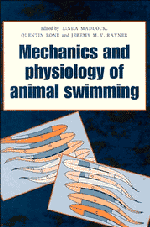Book contents
- Frontmatter
- Contents
- Contributors
- Introduction
- 1 Functional patterns of swimming bacteria
- 2 Buoyancy and swimming in marine planktonic protists
- 3 The role of fins in the competition between squid and fish
- 4 The biology of fish swimming
- 5 Swimming physiology of pelagic fishes
- 6 The mechanical design of the fish muscular system
- 7 How do fish use their myotomal muscle to swim? In vitro simulations of in vivo activity patterns
- 8 The timing of lateral muscle strain and EMG activity in different species of steadily swimming fish
- 9 Swimming in the lamprey: modelling the neural pattern generation, the body dynamics and the fluid mechanics
- 10 Swimming capabilities of Mesozoic marine reptiles: a review
- 11 Stone, bone or blubber? Buoyancy control strategies in aquatic tetrapods
- 12 Functional anatomy of the ‘flight’ apparatus in penguins
- 13 Energy conservation by formation swimming: metabolic evidence from ducklings
- Bibliography
- Index
11 - Stone, bone or blubber? Buoyancy control strategies in aquatic tetrapods
Published online by Cambridge University Press: 05 March 2012
- Frontmatter
- Contents
- Contributors
- Introduction
- 1 Functional patterns of swimming bacteria
- 2 Buoyancy and swimming in marine planktonic protists
- 3 The role of fins in the competition between squid and fish
- 4 The biology of fish swimming
- 5 Swimming physiology of pelagic fishes
- 6 The mechanical design of the fish muscular system
- 7 How do fish use their myotomal muscle to swim? In vitro simulations of in vivo activity patterns
- 8 The timing of lateral muscle strain and EMG activity in different species of steadily swimming fish
- 9 Swimming in the lamprey: modelling the neural pattern generation, the body dynamics and the fluid mechanics
- 10 Swimming capabilities of Mesozoic marine reptiles: a review
- 11 Stone, bone or blubber? Buoyancy control strategies in aquatic tetrapods
- 12 Functional anatomy of the ‘flight’ apparatus in penguins
- 13 Energy conservation by formation swimming: metabolic evidence from ducklings
- Bibliography
- Index
Summary
An air-breathing tetrapod's buoyancy depends in part on the animal's contained gas, and therefore on the ambient pressure and depth. An animal can vary gas content as a hydrostatic control mechanism to reach neutral buoyancy at a particular depth. Alternatively, or additionally, it can compensate for buoyancy hydrodynamically, for example by producing lift forces during swimming: this is most effective for animals which contain less gas, and thus swim faster and deeper. Two extreme evolutionary adaptations can be predicted from this, and have indeed appeared through convergent evolution: body density and submerged lung-volume reduction for fast, cruising swimmers and deep divers (cetaceans, phocid pinnipeds and ichthyosaurs) and body density and submerged lung-volume increase for bottom-walkers (sirenians and placodonts). A third strategy, swallowing stones, maximizes the flexibility of hydrostatic control and enables the identification of a third case of convergent evolution in the manoeuvrable underwater flyers (otariid pinnipeds, penguins, and plesiosaurs).
INTRODUCTION
The marine reptiles, birds and mammals include many of the dominant marine predators and filter feeders of the last 250-odd million years (Carroll, 1988; Massare, 1988). Control of buoyancy is an important adaptation to life in water, yet little is known about how tetrapods in general do so. Although there are important studies on particular groups (some cited in this chapter), there is no one synthesis which explains the bewildering, indeed, apparently contradictory, variety of adaptations commonly ascribed to the need to control buoyancy.
- Type
- Chapter
- Information
- The Mechanics and Physiology of Animal Swimming , pp. 151 - 162Publisher: Cambridge University PressPrint publication year: 1994
- 39
- Cited by



